Polarized Bidirectional Reflectance Distribution Function Matrix Derived from Two-Scale Roughness Theory and Its Applications in Active Remote Sensing
Abstract
:1. Introduction
2. Model and Method
2.1. Two-Scale pBRDF Matrix
2.2. Relationship between NRCSs and the Two-Scale pBRDF Matrix
3. Results
3.1. Numerical Results of Backscattering NRCS
3.2. Numerical Results of Bistatic NRCS
3.3. Comparison with MetOP-C ASCAT Scatterometer
3.4. Comparison with CYGNSS Reflectometry
4. Discussion
5. Conclusions
Author Contributions
Funding
Data Availability Statement
Acknowledgments
Conflicts of Interest
References
- Alerskans, E.; Zinck, A.S.P.; Nielsen-Englyst, P.; Høyer, J.L. Exploring machine learning techniques to retrieve sea surface temperatures from passive microwave measurements. Remote Sens. Environ. 2022, 281, 113–220. [Google Scholar] [CrossRef]
- Chi, J.; Kim, H.C. Retrieval of daily sea ice thickness from AMSR2 passive microwave data using ensemble convolutional neural networks. GISci. Remote Sens. 2021, 58, 812–830. [Google Scholar] [CrossRef]
- Le Vine, D.M.; Dinnat, E.P. The Multifrequency Future for Remote Sensing of Sea Surface Salinity from Space. Remote Sens. 2020, 12, 1381. [Google Scholar] [CrossRef]
- Pospelov, M.N. Surface wind speed retrieval using passive microwave polarimetry: The dependence on atmospheric stability. IEEE Trans. Geosci. Remote Sens. 1996, 34, 1166–1171. [Google Scholar] [CrossRef]
- Weng, F.; Grody, N.C. Retrieval of cloud liquid water using the special sensor microwave imager (SSM/I). J. Geophys. Res. Atmos. 1994, 99, 25535–25551. [Google Scholar]
- Tian, Y.; Wen, B.; Zhou, H.; Wang, C.; Yang, J.; Huang, W. Wave Height Estimation from First-Order Backscatter of a Dual-Frequency High Frequency Radar. Remote Sens. 2017, 9, 1186. [Google Scholar] [CrossRef]
- Yang, J.; Zhang, J.; Jia, Y.; Fan, C.; Cui, W. Validation of Sentinel-3A/3B and Jason-3 Altimeter Wind Speeds and Significant Wave Heights Using Buoy and ASCAT Data. Remote Sens. 2020, 12, 2079. [Google Scholar] [CrossRef]
- Yu, P.; Xu, W.X.; Zhong, X.J.; Johannessen, J.A.; Yan, X.H.; Geng, X.P.; He, Y.R.; Lu, W.F. A Neural Network Method for Retrieving Sea Surface Wind Speed for C-Band SAR. Remote Sens. 2022, 14, 2269. [Google Scholar] [CrossRef]
- Robitaille, P.M. On the validity of Kirchhoff’s law of thermal emission. IEEE Trans. Plasma Sci. 2003, 31, 1263–1267. [Google Scholar] [CrossRef]
- Veysoglu, M.E.; Yueh, H.A.; Shin, R.T.; Kong, J.A. Polarimetric Passive Remote Sensing of Periodic Surfaces. J. Electromagn. Waves Appl. 1991, 5, 267–280. [Google Scholar] [CrossRef]
- Yueh, S.H.; Kwok, R. Electromagnetic fluctuations for anisotropic media and the generalized Kirchhoff’s law. Radio Sci. 1993, 28, 471–480. [Google Scholar] [CrossRef]
- Priest, R.; Meier, S. Polarimetric microfacet scattering theory with applications to absorptive and reflective surfaces. Opt. Eng. 2002, 41, 988–993. [Google Scholar] [CrossRef]
- Hyde, M.W.; Schmidt, J.D.; Havrilla, M.J. A geometrical optics polarimetric bidirectional reflectance distribution function for dielectric and metallic surfaces. Opt. Express 2009, 17, 22138–22153. [Google Scholar] [CrossRef] [PubMed]
- Diner, D.J.; Xu, F.; Martonchik, J.V.; Rheingans, B.E.; Geier, S.; Jovanovic, V.M.; Davis, A.; Chipman, R.A.; McClain, S.C. Exploration of a Polarized Surface Bidirectional Reflectance Model Using the Ground-Based Multiangle SpectroPolarimetric Imager. Atmosphere 2012, 3, 591–619. [Google Scholar] [CrossRef]
- Boukabara, S.A.; Eymard, L.; Guillou, C.; Lemaire, D.; Sobieski, P.; Guissard, A. Development of a modified two-scale electromagnetic model simulating both active and passive microwave measurements: Comparison to data remotely sensed over the ocean. Radio Sci. 2002, 37, 1–11. [Google Scholar] [CrossRef]
- Sobieski, P.; Guissard, A.; Baufays, C. Synergic inversion technique for active and passive microwave remote sensing of the ocean. IEEE Trans. Geosci. Remote Sens. 1991, 29, 391–406. [Google Scholar] [CrossRef]
- English, S.; Prigent, C.; Johnson, B.; Yueh, S.; Dinnat, E.; Boutin, J.; Newman, S.; Anguelova, M.; Meissner, T.; Kazumori, M.; et al. Reference-Quality Emission and Backscatter Modeling for the Ocean. Bull. Am. Meteorol. Soc. 2020, 101, E1593–E1601. [Google Scholar] [CrossRef]
- He, L.; Weng, F. Improved Microwave Ocean Emissivity and Reflectivity Models Derived from Two-Scale Roughness Theory. Adv. At. Sci. 2023, 40, 1923–1938. [Google Scholar] [CrossRef]
- Guo, L.X.; Guo, X.Y.; Zhang, L.B. Bidirectional reflectance distribution function modeling of one-dimensional rough surface in the microwave band. Chin. Phys. B 2014, 23, 114102. [Google Scholar] [CrossRef]
- David, L.; Fawwaz, U. Microwave Radar and Radiometric Remote Sensing; Artech: Morristown, NJ, USA, 2015; Volume 1. [Google Scholar]
- Bettenhausen, M.H.; Smith, C.K.; Bevilacqua, R.M.; Wang, N.Y.; Gaiser, P.W.; Cox, S. A nonlinear optimization algorithm for WindSat wind vector retrievals. IEEE Trans. Geosci. Remote Sens. 2006, 44, 597–610. [Google Scholar] [CrossRef]
- Dinnat, E.P.; Boutin, J.; Caudal, G.; Etcheto, J.; Waldteufel, P. Influence of sea surface emissivity model parameters at L-band for the estimation of salinity. Int. J. Remote Sens. 2002, 23, 5117–5122. [Google Scholar] [CrossRef]
- Johnson, J.; Theunissen, W.H.; Ellingson, S.W. A Study of Sea Emission Models for WindSAT. In Proceedings of the IGARSS ’03—2003 IEEE International Geoscience and Remote Sensing Symposium, Toulouse, France, 21–25 July 2003; pp. 717–719. [Google Scholar]
- Lyzenga, D.R.; Vesecky, J.F. Two-Scale Polarimetric Emissivity Model: Efficiency Improvements and Comparisons with Data. Prog. Electromagn. Res. 2002, 37, 205–219. [Google Scholar] [CrossRef]
- Pierdicca, N.; Marzano, F.S.; Guerriero, L.; Pampaloni, P. On the Effect of Atmospheric Emission Upon the Passive Microwave Polarimetric Response of an Azimuthally Anisotropic Sea Surface. J. Electromagn. Waves Appl. 2000, 14, 355–358. [Google Scholar] [CrossRef]
- Yueh, S.H.; Nghiem, S.V.; Kwok, R. Comparison of a polarimetric scattering and emission model with ocean backscatter and brightness measurements. In Proceedings of the IGARSS ’94—1994 IEEE International Geoscience and Remote Sensing Symposium, Pasadena, CA, USA, 8–12 August 1994; Volume 1, pp. 258–260. [Google Scholar]
- Anderson, R. Matrix description of radiometric quantities. Appl. Opt. 1991, 30, 858–867. [Google Scholar] [CrossRef] [PubMed]
- Flynn, D.S.; Alexander, C.J.O.E. Polarized surface scattering expressed in terms of a bidirectional reflectance distribution function matrix. Opt. Eng. 1995, 34, 1646–1650. [Google Scholar]
- Sun, Y. Statistical ray method for deriving reflection models of rough surfaces. J. Opt. Soc. Am. 2007, 24, 724–744. [Google Scholar] [CrossRef] [PubMed]
- Torrance, K.E.; Sparrow, E.M. Theory for Off-Specular Reflection from Roughened Surfaces*. J. Opt. Soc. Am. 1967, 57, 1105–1114. [Google Scholar] [CrossRef]
- Mobley, C.D. Light and Water: Radiative Transfer in Natural Waters; American Meteorological Society: Boston, MA, USA, 1994. [Google Scholar]
- Hapke, B. Theory of Reflectance and Emittance Spectroscopy, 2nd ed.; Cambridge University Press: Cambridge, UK, 2012. [Google Scholar]
- Kazumori, M.; English, S.J. Use of the ocean surface wind direction signal in microwave radiance assimilation. Q. J. R. Meteorol. Soc. 2014, 141, 1354–1375. [Google Scholar] [CrossRef]
- Kilic, L.; Prigent, C.; Jimenez, C.; Turner, E.; Hocking, J.; English, S.; Thomas, M.; Emmanuel, D. Development of the SURface Fast Emissivity Model for Ocean (SURFEM-Ocean) Based on the PARMIO Radiative Transfer Model. Earth Space Sci. 2023, 10, 11. [Google Scholar] [CrossRef]
- Saunders, R.; Brunel, P.; English, S.; Bauer, P.; O’Keeffe, U.; Francis, P.; Rayer, P. RTTOV-8-Science and Validation Report; Met Office Forecasting and Research Technical Document (Technical Report No. NWPSAF-MO-TV-007); EUMETSAT: Darmstadt, Germany, 2006. [Google Scholar]
- Lee, J.S.; Pottier, E. Polarimetric Radar Imaging: From Basics to Applications; CRC Press: Boca Raton, FL, USA, 2009. [Google Scholar]
- Voronovich, A.G.; Zavorotny, V.U. Full-Polarization Modeling of Monostatic and Bistatic Radar Scattering from a Rough Sea Surface. IEEE Trans. Antennas Propag. 2014, 62, 3. [Google Scholar] [CrossRef]
- Liu, Q.; Weng, F.; English, S.J. An Improved Fast Microwave Water Emissivity Model. IEEE Trans. Geosci. Remote Sens. 2011, 49, 1238–1250. [Google Scholar] [CrossRef]
- Stogryn, A. The emissivity of sea foam at microwave frequencies. J. Geophys. Res. (1896–1977) 1972, 77, 1658–1666. [Google Scholar] [CrossRef]
- Monahan, E.C.; O‘Muircheartaigh, I.G. Whitecaps and the passive remote sensing of the ocean surface. Int. J. Remote Sens. 1986, 7, 627–642. [Google Scholar] [CrossRef]
- Yueh, S.H. Modeling of wind direction signals in polarimetric sea surface brightness temperatures. IEEE Trans. Geosci. Remote Sens. 1997, 35, 1400–1418. [Google Scholar] [CrossRef]
- Yueh, S.H.; Wilson, W.J.; Dinardo, S. Polarimetric radar remote sensing of ocean surface wind. IEEE Trans. Geosci. Remote Sens. 2002, 40, 793–800. [Google Scholar] [CrossRef]
- Zhang, B.; Perrie, W.; Vachon, P.; Li, X.; Pichel, W.; Guo, J.; He, Y. Ocean Vector Winds Retrieval from C-Band Fully Polarimetric SAR Measurements. IEEE Trans. Geosci. Remote Sens. 2012, 50, 4252–4261. [Google Scholar] [CrossRef]
- Donald, J.H.; Thompson, R.; Mouche, A.; Winstead, S.; Sterner, R.; Monaldo, M. Comparison of high-resolution wind fields extracted from TerraSAR-X SAR imagery with predictions from the WRF mesoscale model. J. Geophys. Res. 2012, 117, c2. [Google Scholar]
- Elfouhaily, T.; Thompson, D.R.; Vandemark, D.; Chapron, B. A New Bistatic Model for Electromagnetic Scattering from Perfectly Conducting Random Surfaces. Waves Random Media 2001, 9, 33–43. [Google Scholar] [CrossRef]
- Shao, W.; Li, X.; Lehner, S.; Guanc, C. Development of polarization ratio model for sea surface wind field retrieval from TerraSAR-X HH polarization data. Int. J. Remote Sens. 2014, 35, 11–12. [Google Scholar] [CrossRef]
- Yueh, S.H.; Tang, W.Q.; Fore, G.; Alexander, F.; Neumann, G.; Hayashi, A.; Freedman, A.; Chaubell, J.; Lagerloef, G. L-Band Passive and Active Microwave Geophysical Model Functions of Ocean Surface Winds and Applications to Aquarius Retrieval. IEEE Trans. Geosci. Remote Sens. 2013, 51, 4619–4632. [Google Scholar] [CrossRef]
- Ruf, C.; Lyons, A.; Unwin, M.; Dickinson, J.; Rose, R.; Rose, D.; Vincent, M. CYGNSS: Enabling the Future of Hurricane Prediction [Remote Sensing Satellites]. IEEE Geosci. Remote Sens. Mag. 2013, 1, 52–67. [Google Scholar] [CrossRef]
- Gleason, S.T.; Ruf, C.S.; Clarizia, M.P.; O‘Brien, A.J. Calibration and Unwrapping of the Normalized Scattering Cross Section for the Cyclone Global Navigation Satellite System. IEEE Trans. Geosci. Remote Sens. 2016, 54, 2495–2509. [Google Scholar] [CrossRef]
- Clarizia, M.P. Investigating the Effect of Ocean Waves on GNSS-R Microwave Remote Sensing Measurements. Ph.D. Thesis, University of Southampton, Southampton, UK, 2012; 219p. [Google Scholar]
- Huang, F.; Garrison, J.; Leidner, S.; Annane, B.; Hoffman, R.; Giuseppe, G.; Stoffelen, A. A Forward Model for Data Assimilation of GNSS Ocean Reflectometry Delay-Doppler Maps. IEEE Trans. Geosci. Remote Sens. 2021, 59, 2643–2656. [Google Scholar] [CrossRef]
- Miranda, J.; Vall-llossera, M.; Camps, A.; Duffo, N. Sea surface emissivity at L-band: Swell effects. IEEE Int. Geosci. Remote Sens. Symp. 2002, 5, 2623–2625. [Google Scholar]
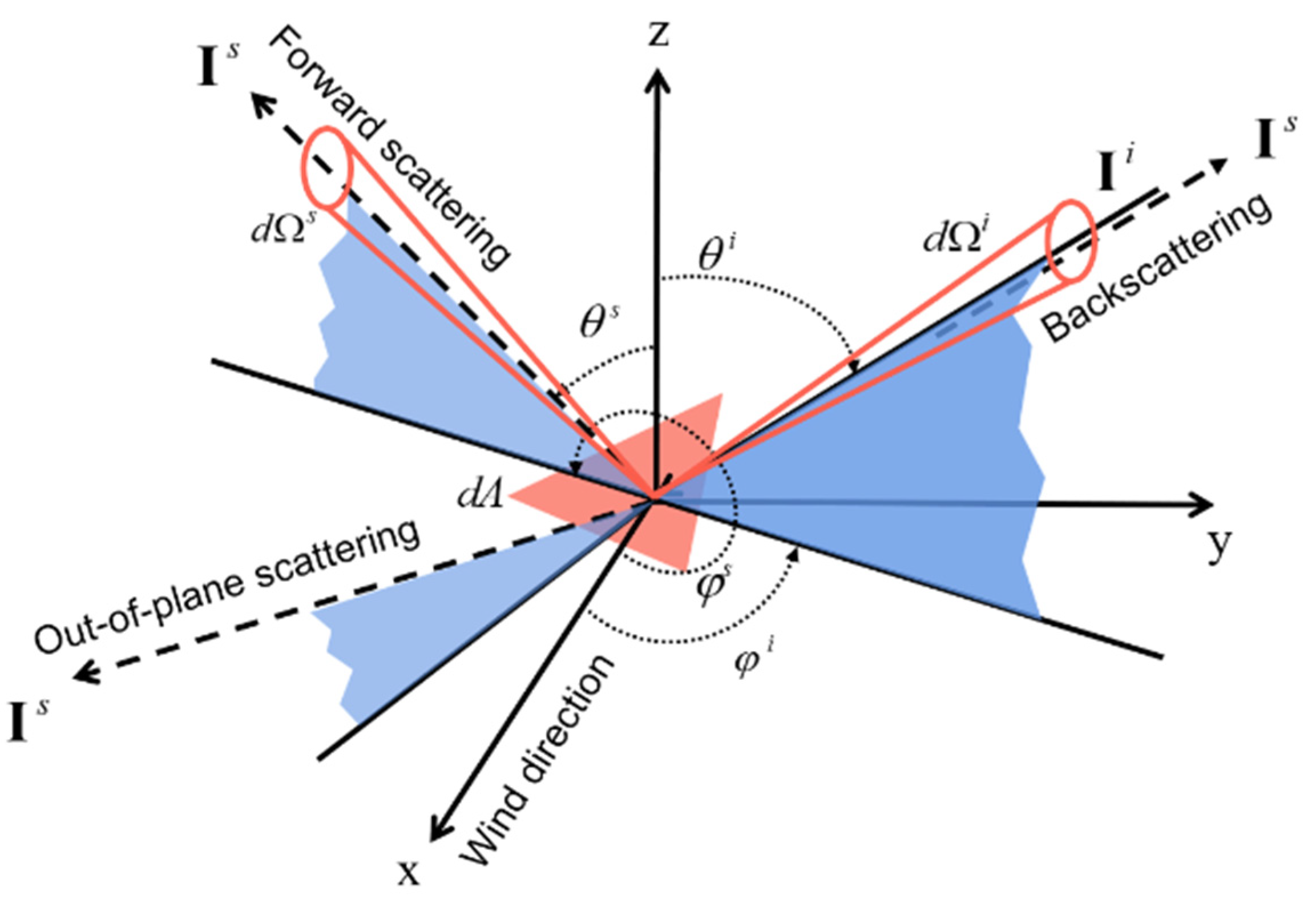
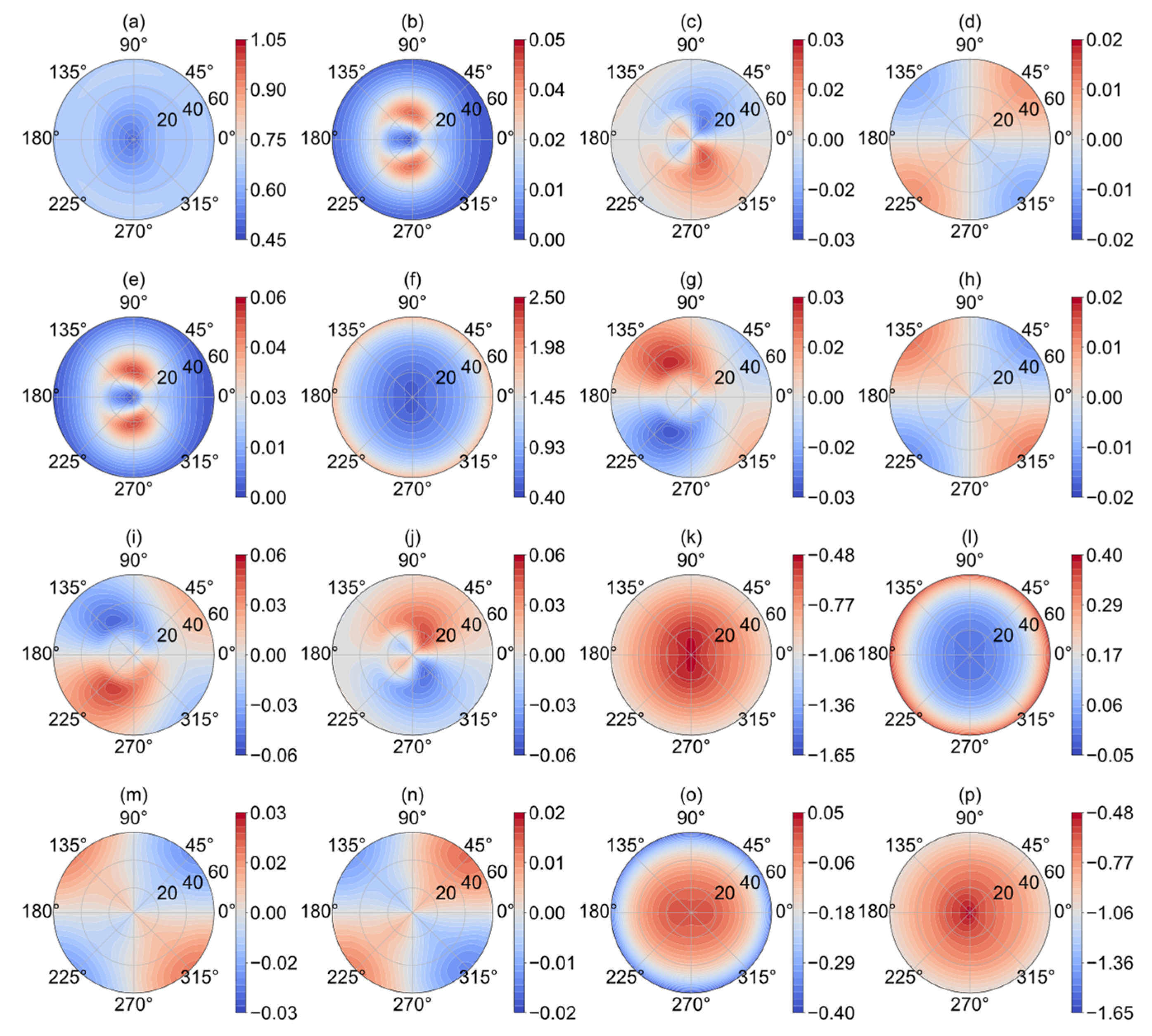
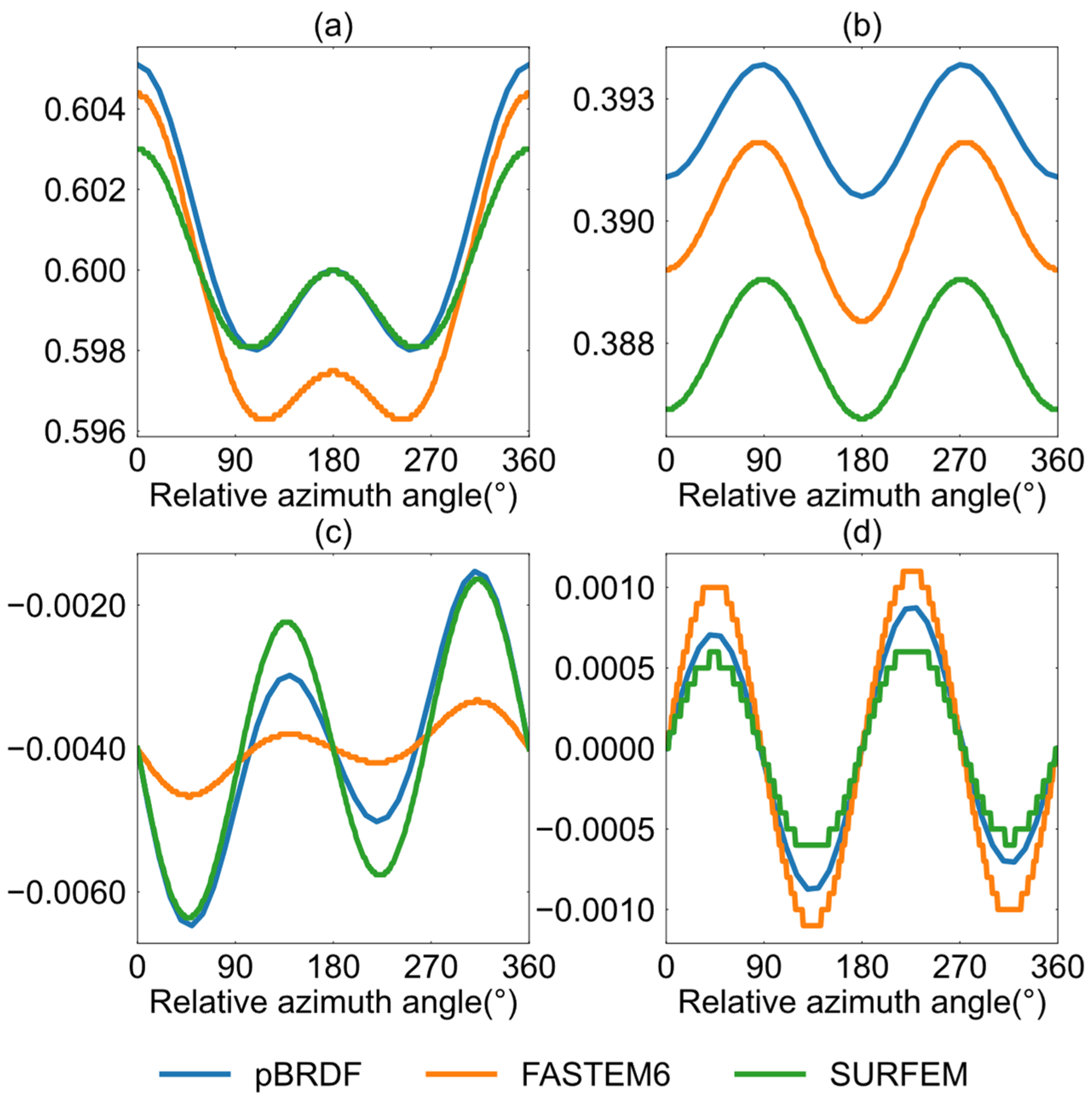
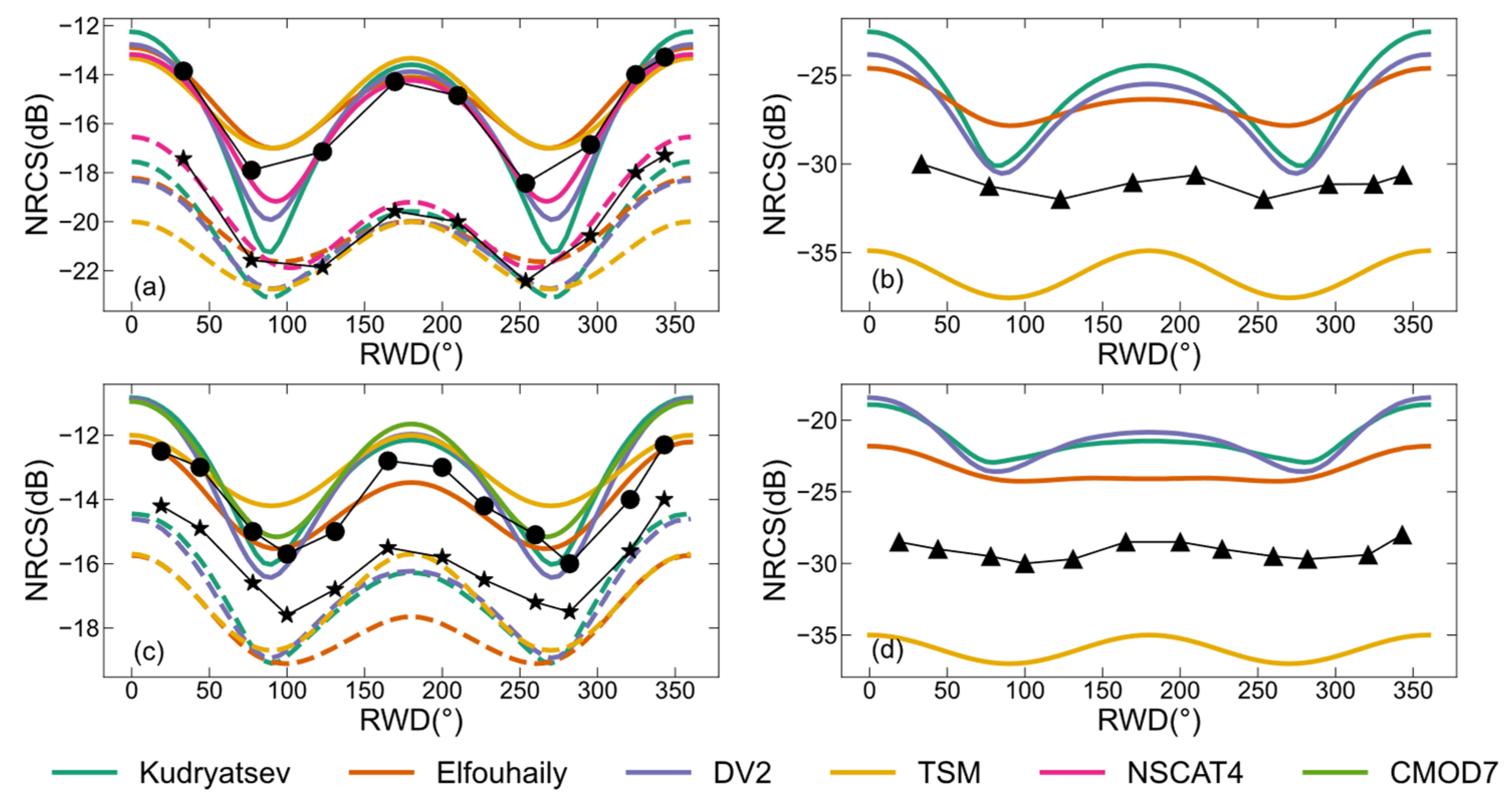

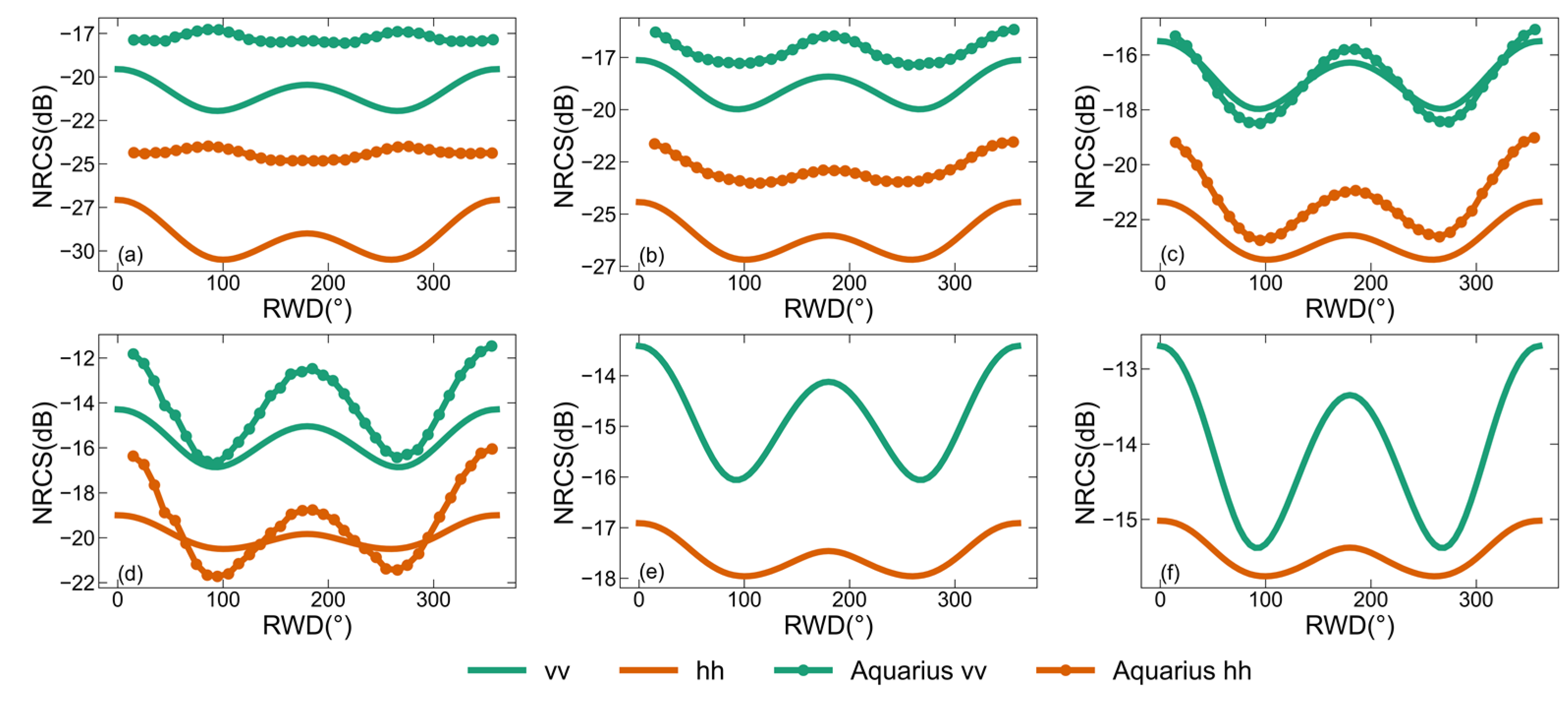
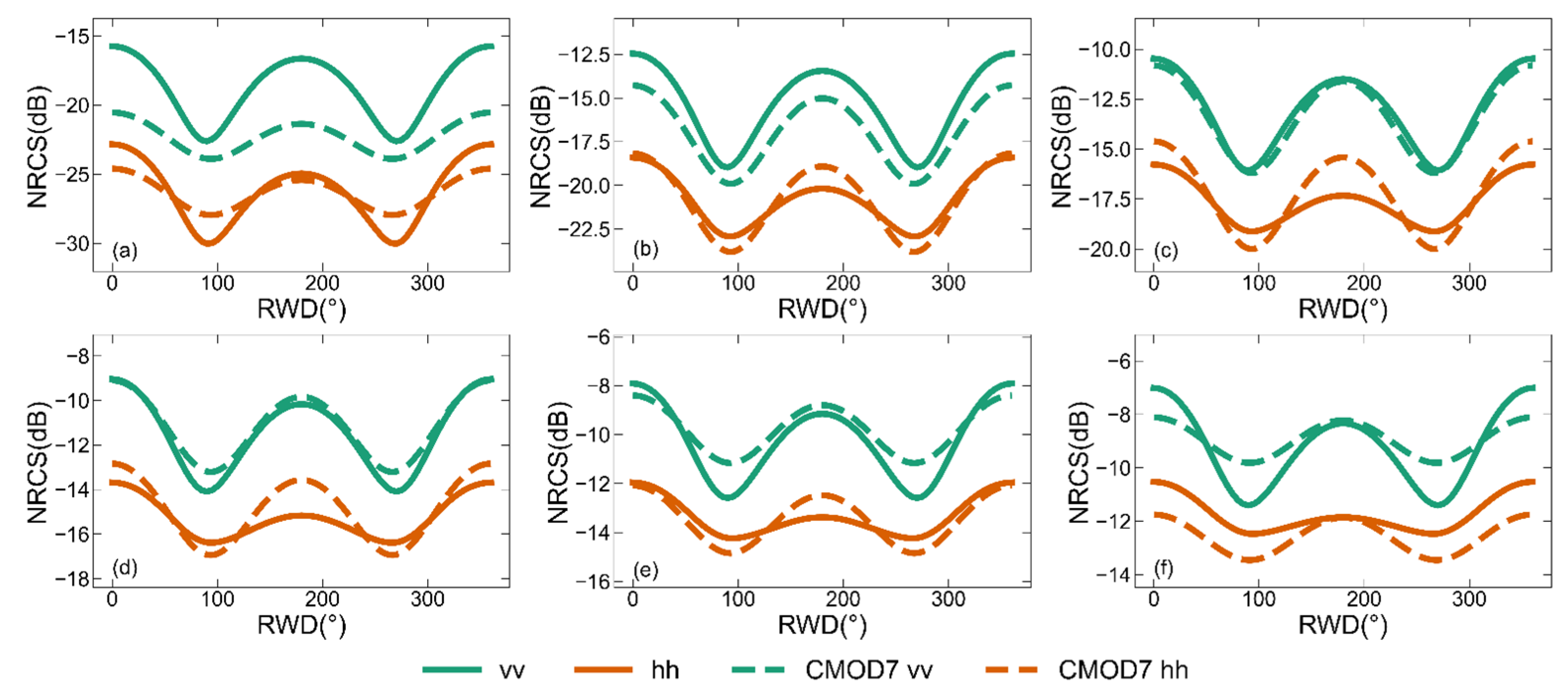
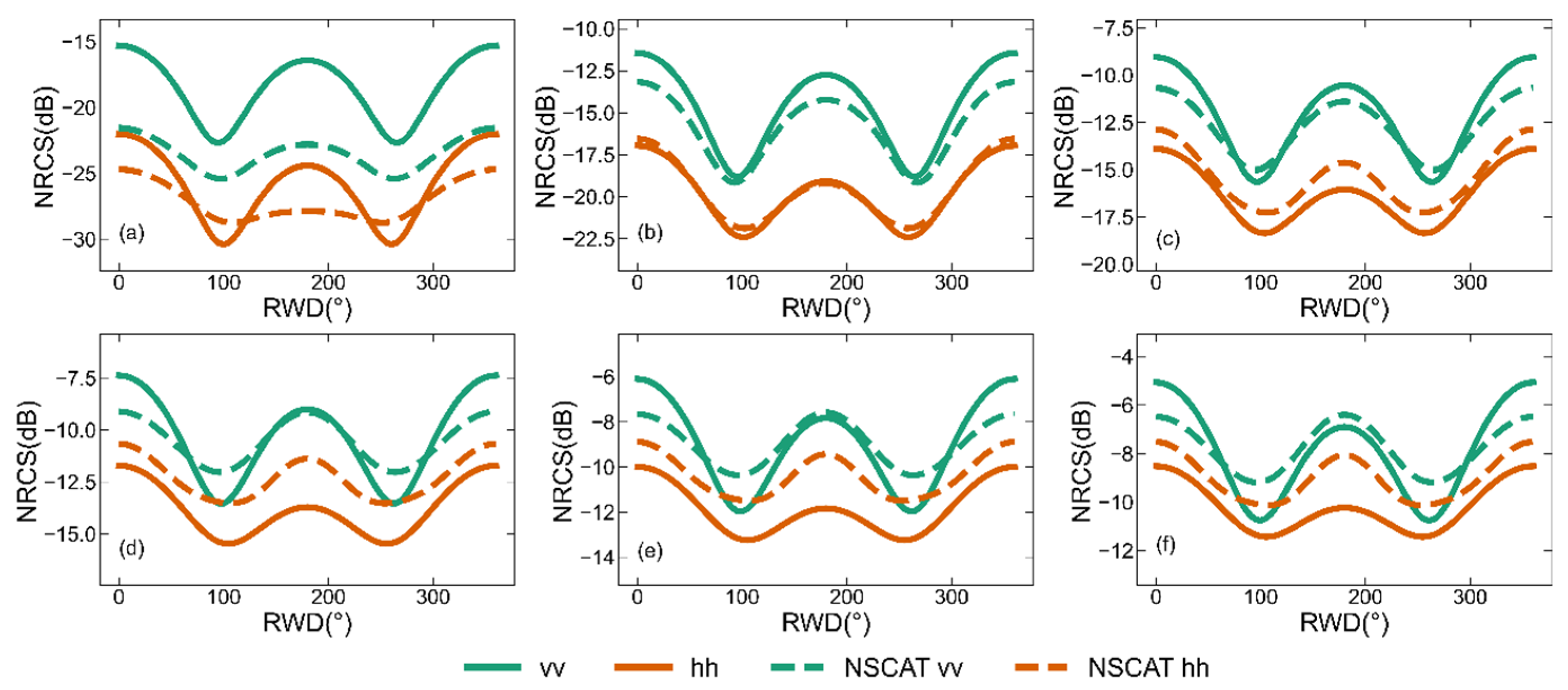
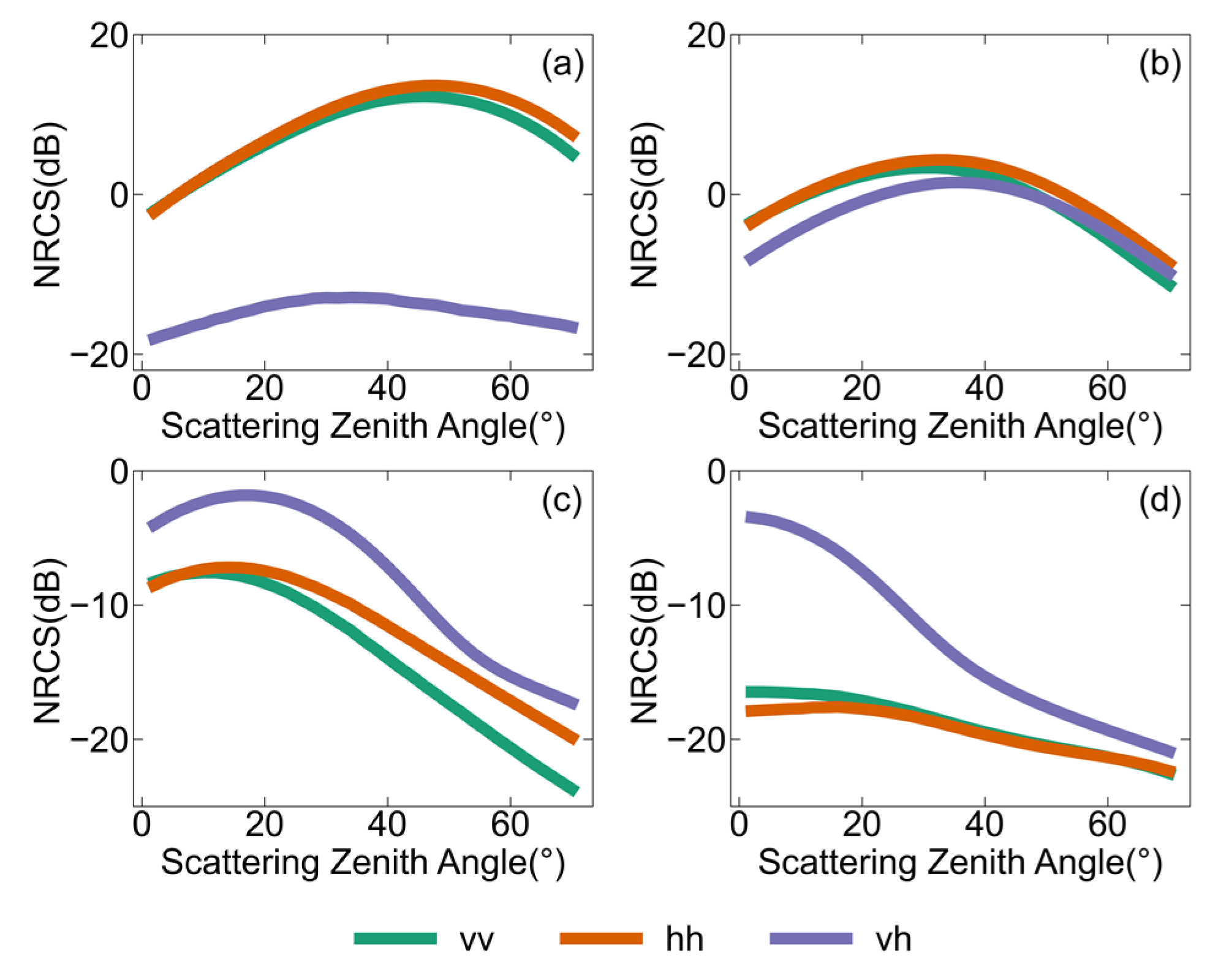
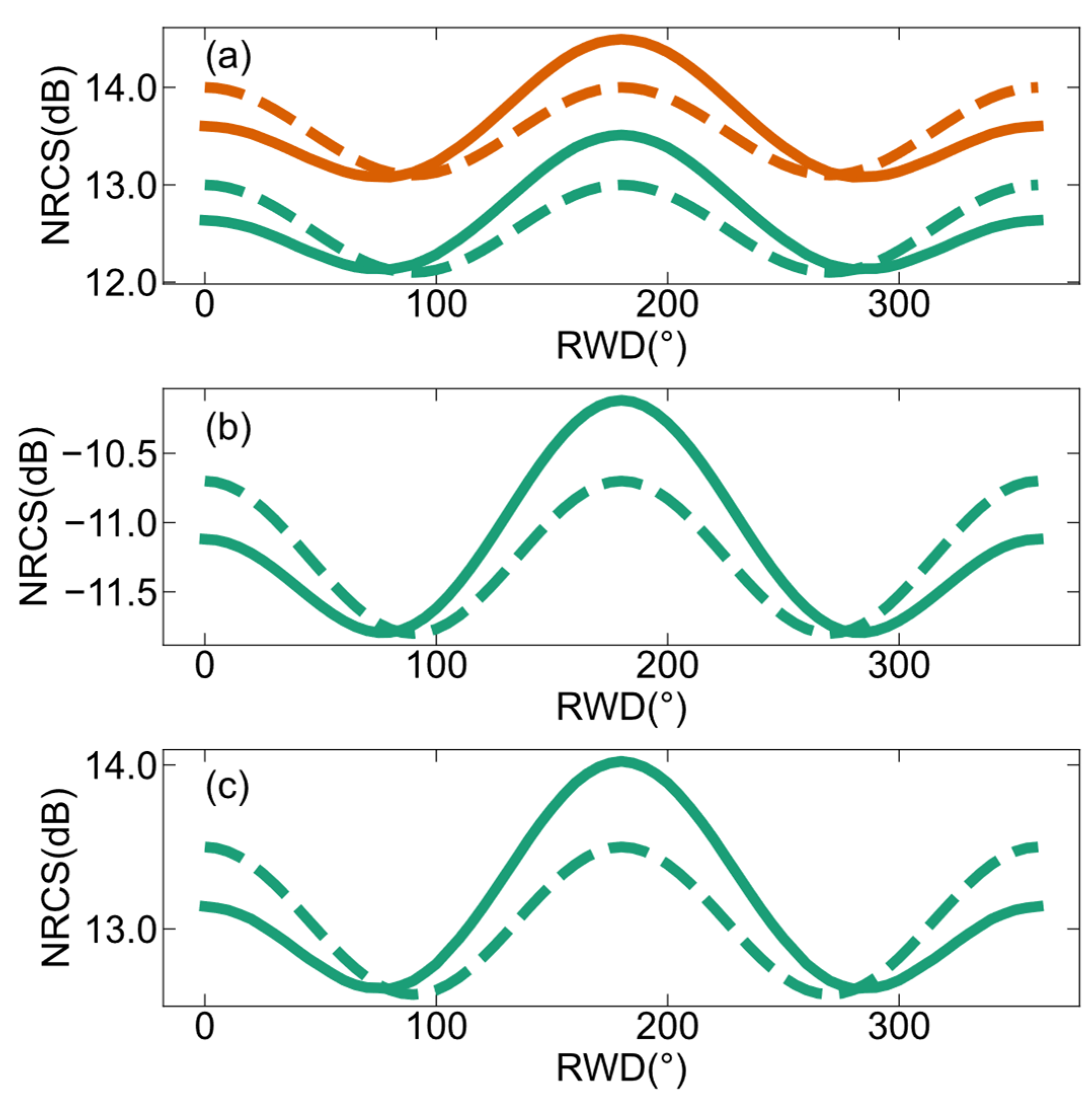
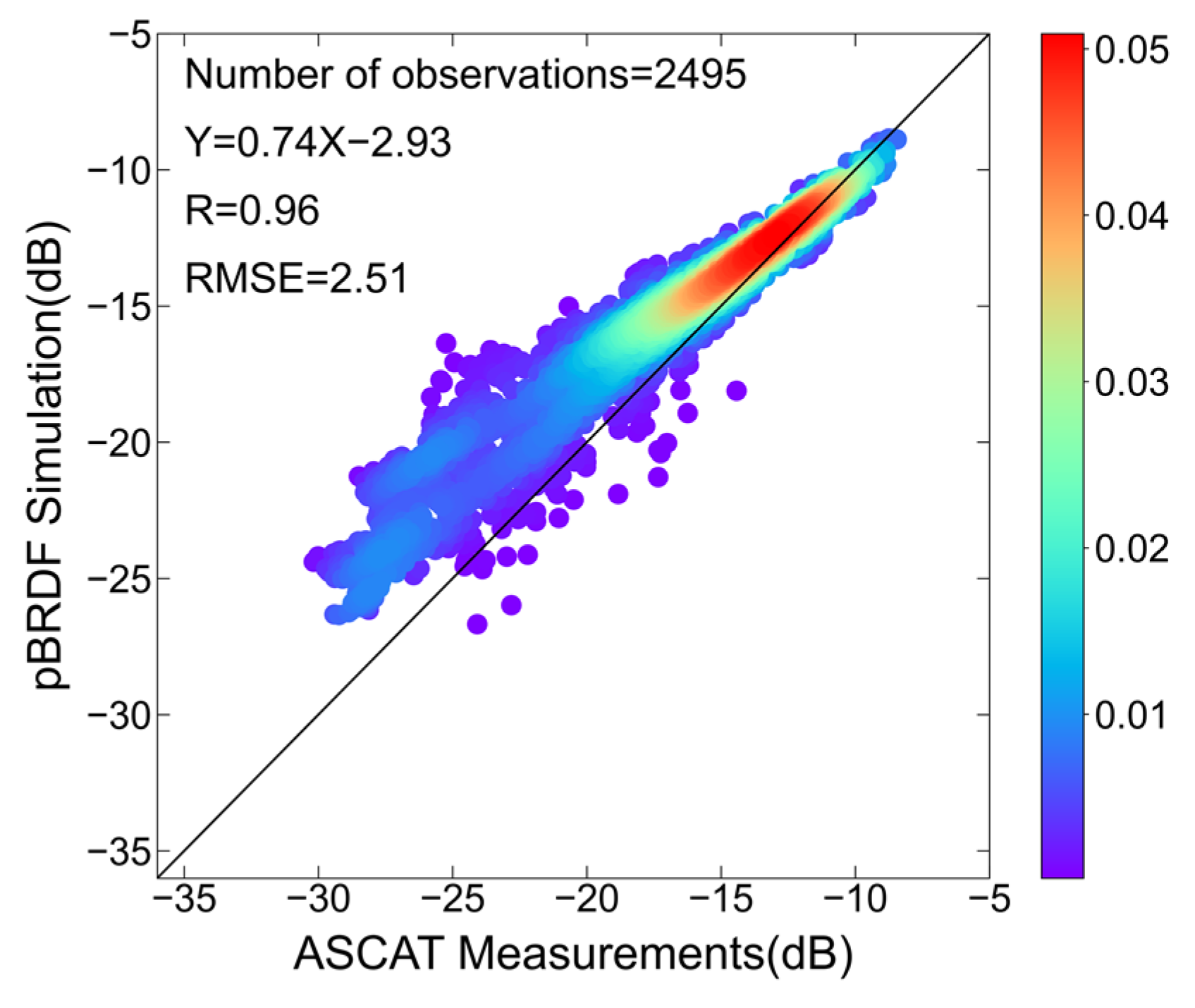
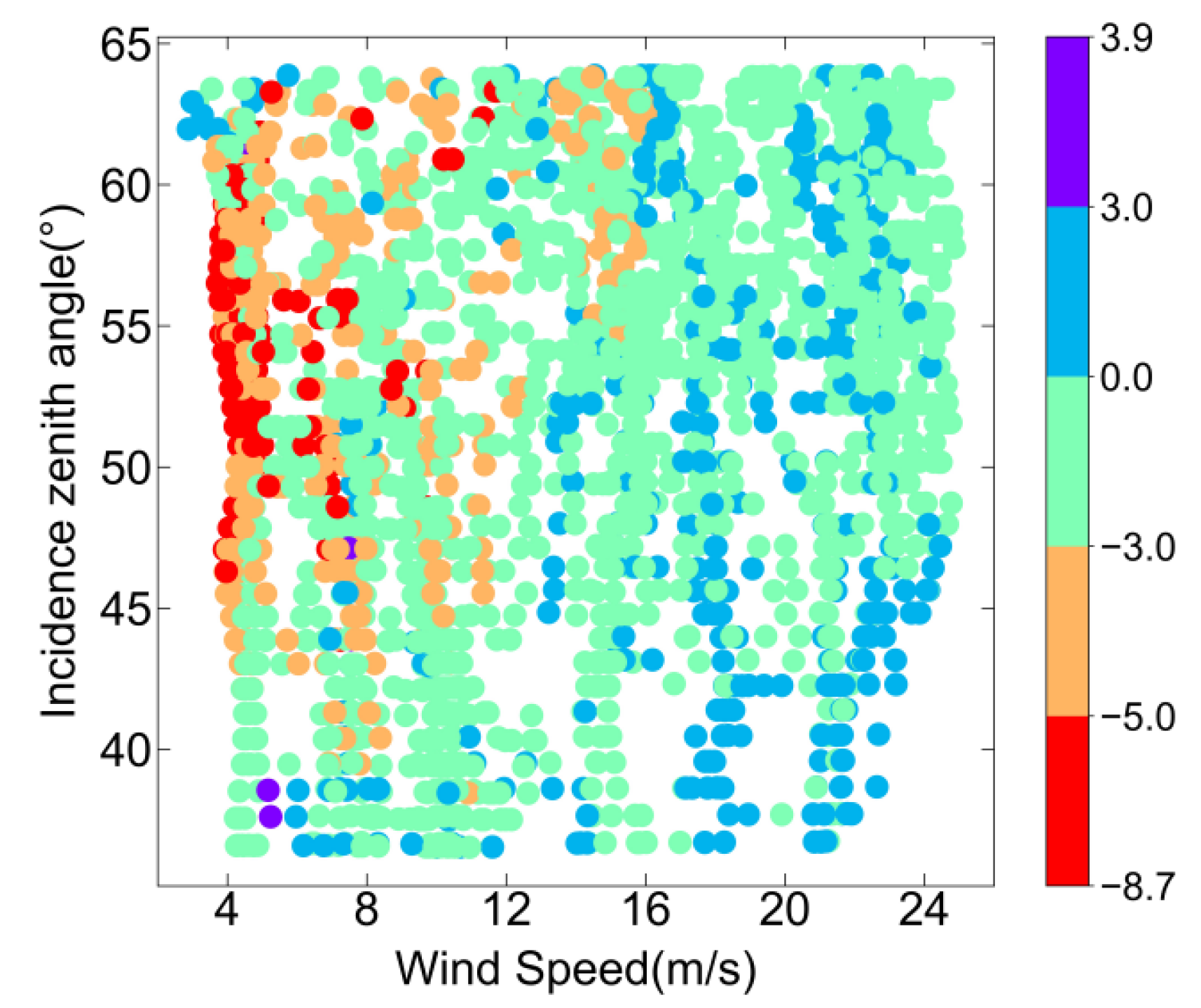
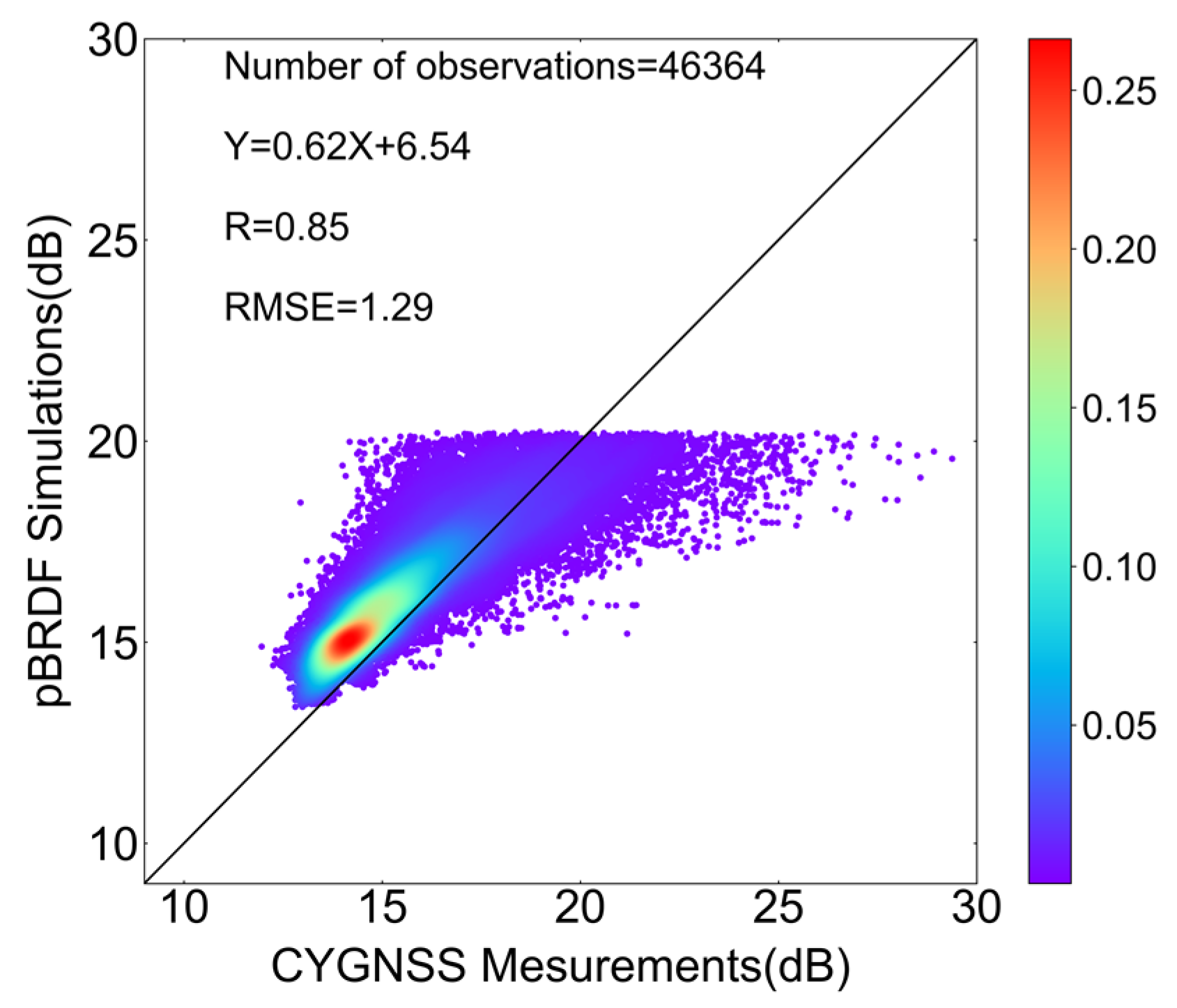
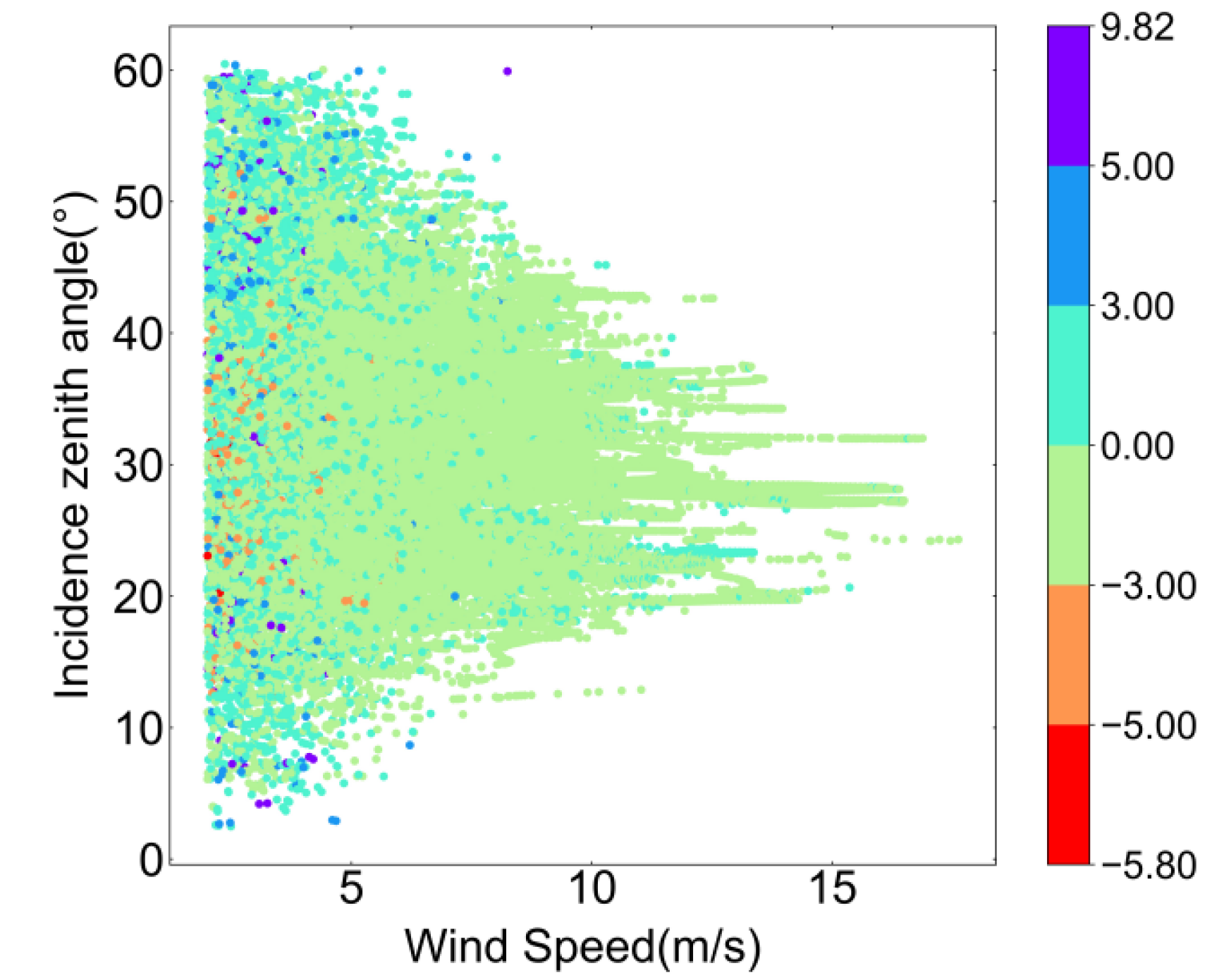
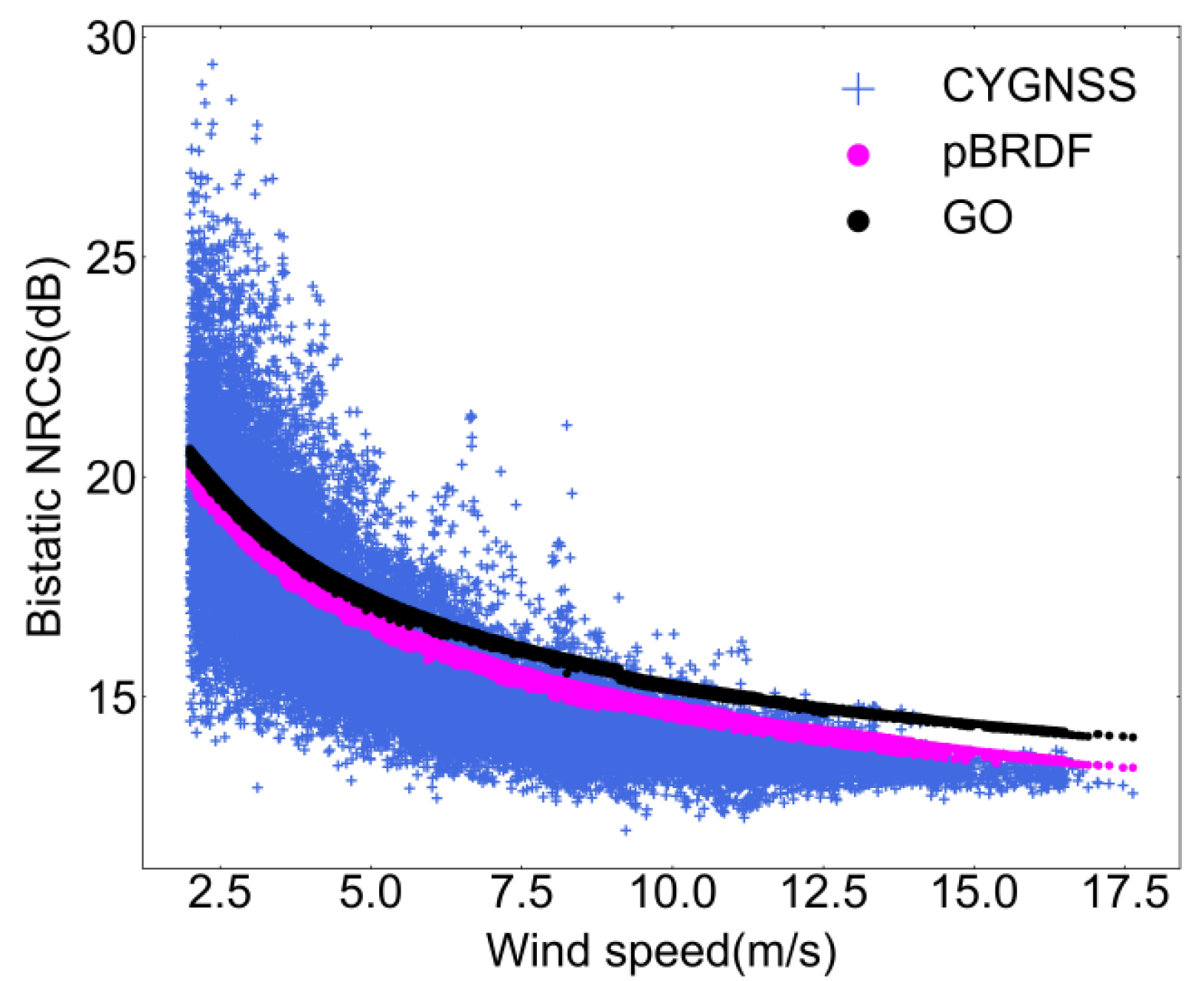
Disclaimer/Publisher’s Note: The statements, opinions and data contained in all publications are solely those of the individual author(s) and contributor(s) and not of MDPI and/or the editor(s). MDPI and/or the editor(s) disclaim responsibility for any injury to people or property resulting from any ideas, methods, instructions or products referred to in the content. |
© 2024 by the authors. Licensee MDPI, Basel, Switzerland. This article is an open access article distributed under the terms and conditions of the Creative Commons Attribution (CC BY) license (https://creativecommons.org/licenses/by/4.0/).
Share and Cite
He, L.; Weng, F.; Wen, J.; Jia, T. Polarized Bidirectional Reflectance Distribution Function Matrix Derived from Two-Scale Roughness Theory and Its Applications in Active Remote Sensing. Remote Sens. 2024, 16, 1551. https://doi.org/10.3390/rs16091551
He L, Weng F, Wen J, Jia T. Polarized Bidirectional Reflectance Distribution Function Matrix Derived from Two-Scale Roughness Theory and Its Applications in Active Remote Sensing. Remote Sensing. 2024; 16(9):1551. https://doi.org/10.3390/rs16091551
Chicago/Turabian StyleHe, Lingli, Fuzhong Weng, Jinghan Wen, and Tong Jia. 2024. "Polarized Bidirectional Reflectance Distribution Function Matrix Derived from Two-Scale Roughness Theory and Its Applications in Active Remote Sensing" Remote Sensing 16, no. 9: 1551. https://doi.org/10.3390/rs16091551




